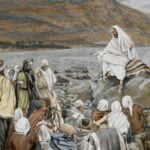Every now and then, I catch myself tuning in to the Antiques Roadshow, mostly in order to see the reaction of those who have brought along heirlooms when they discover their value. Last week a woman brought in two not very impressive plates, one of which was broken in half and poorly held together with bits of wire. They turned out to be early Delft ware—worth £20,000 each! She literally burst into tears with amazement and nervous excitement. ‘I brought them here just shoved in my handbag!’
On the other hand, people sometimes have something in their homes that they think is so precious that they never dare to handle it, to look at it closely and appreciate it. I think these two reactions illustrate common responses to the passage in the lectionary for the Second Sunday before Lent in Year B, John 1.1–14. On the one hand, we know it well enough, not least because it forms the climax of the traditional service of Nine Lessons and Carols at Christmas (and we might be wondering why we are reading it now…!). On the other hand, the preacher, knowing how valuable and important this passage is, might be nervous about touching it at all, lest a crass comment or poor reflection sullies its majesty. I confess to feeling slightly nervous writing a commentary this morning! Richard Burridge comments (in his BRF People’s Bible Commentary):
The opening of John’s gospel is one of the most magnificent pieces of religious literature ever written.
Yet handle it we must! And there is no real reason why we shouldn’t read this carefully, and note what it says, in the way we would with any other passage. Bute alongside looking at the detail of the text, we need to note four things which make this a daunting text to engage with—but which might help us to appreciate it all the more.
The first feature is the carefully crafted poetic structure of the text, which uses two kinds of parallelism, both evident in the opening verses. The text opens with step (or ‘step stair’) parallelism, in which successive phrases or sentences begin with the final term of the previous clause; in ancient rhetoric this was called anadiplosis, or ‘folding back’. Thus we have:
Beginning—word
word—God
God—word
beginning—God
Life—light
light—darkness
darkness—mastery
The effect of this is to create a sense of movement, even downward movement, so that the literary form of writing actually matches the theological movement that the text is describing—the coming of the pre-existent Word into the world in the form of human flesh.
Alongside this, there is frequent synthetic or antithetic parallelism, either repeating or contrasting ideas within successive phrases. Thus ‘Through him all things were made’ is repeated in the double negative ‘Without him nothing has been made that is’. Again, we find repetition and contrast in the description of John (the Baptist), who was ‘a witness who came to bear witness’ but ‘he was not the light, but came to bear witness about the light’.
In the third main section from verse 9, we then get an interweaving of the two poetical techniques, with the step parallelism in ‘witness—light, light—world, world/own—recognise/receive, receive—born, born—of God’. Within that there are contrasts between his coming but not being recognised, is own people not receiving him, and those who are born of God being not born of three other causes or means.
Altogether, this gives the passage a sense of being tightly woven together into a seamless whole. I hope this comes across in my reading of the passage—which, because of this structure, is not that difficult to learn by heart (a good exercise to do if you are preaching on this passage).
The second feature of the text is the sharp contrast between different styles of language in different sections, often closely juxtaposed. Jo-Ann Brant (Paideia p 24) outlines the three styles of prose in ancient rhetoric: grand; middle; and plain.
We can see this change, from grand to plain from verses 4 to 5, a move to the middle style in verse 9, and the reversion the grand style again in verse 14. This movement brings a sense of texture and variety, which sits in contrast to the sense of integration and unity arising from the parallelism above. And the contrast between the grand and the plain models something that we find all through the gospel, the juxtaposition of grand theological claims with the mundane reality of Jesus’ human existence. In this gospel Jesus is the one who was eternally pre-existent with the Father, more explicitly and clearly than in the other gospels—yet he is the one who, more obviously, is hungry, thirsty, lonely and isolated, rejected and grief stricken.
This passage also resembles an ancient encomium or hymn of praise to a hero or victorious warrior. Such a eulogy would usually include a description of the hero’s origins, in terms of homeland or family, his or her upbringing, the person’s marvellous deeds, and a comparison with others who are inferior, concluding with some majestic hymn of praise. Jesus’ origins were not merely in Nazareth, but with God in eternity; his ‘upbringing’ was actually a down-coming; he has brought light and life to the whole world; he is far superior to even those esteemed as an exemplar of Jewish piety (see Josephus, Ant. 18.116–19 on John the Baptist); and ‘we have seen his glory’.
If this passage makes use of these different rhetorical strategies, and leads to a response of praise, then perhaps our preaching on it should do the same.
The third challenging feature of this passage is the richly allusive terminology that the author uses.
The study of no other work in John’s vocabulary has preoccupied Johannine scholars as much as logos. (Jo-Ann Brant, p 25).
There are three main streams of thought which converge in this term. From a Greek philosophical context, and particularly Stoic thinking, the logos is the rational principle which brings order and reason to the world; as early as the sixth century BC, Heraclitus use the word to refer to the eternal principle of order in the cosmos. (Coincidentally, Heraclitus was known for his use of word plays, paradox, and arguing for a unity of opposites in the harmony of the world.)
The second is the Old Testament idea of the ‘word of the Lord’, which both comes to the prophets as an almost tangible entity, but also represents God’s creative power in the Genesis narratives. There are occasions (such as Is 55.11) where ‘the word of God’ almost appears to be a distinctive agent, with its own intention and action, in parallel to ‘the spirit of the Lord’ which describes God in his active presence in the world.
Thirdly, the wisdom tradition in the Old Testament and then in Second Temple Jewish texts (Sirach 1.1–4, 24.8, Wisdom 9.1–2) often represents Wisdom as a personified agent, at God’s right hand and working with God as an agent of creation, most notably in the female figure in Proverbs 8.22–23 and 30. Philo of Alexandria was a key figure who blended Greek philosophical ideas with Jewish theological perspectives; the Fourth Gospel does not do this in the same way, despite using terms that would resonate with Greek philosophy, since his language is grounded in the reality of Jesus as the word become flesh.
The word logos then prepares the audience to understand Jesus as an authoritative agent who reveals God’s activity and glory through his speech and actions (Brant, p 26).
Related to this, the author uses a number of terms with important resonances with the OT. The language of light connects with the beginning of the creation narrative, with God’s presence in the exodus as a pillar of flame, with the call of Israel to be a light to the nations, and with the dawning light of God’s presence with his people (Is 9.2). The Word becomes flesh and ‘tabernacles’ amongst us. The verb skenoo is related to the noun skene meaning ‘tent’; during the exodus wanderings, the presence of God’s shekinah glory inhabited the moveable tent (or ‘tabernacle’ which we get from the Latin term for tent, tabernaculum) which moved with the people, and now the presence of the Father’s glory inhabits the moveable body of the person Jesus.
There is a slightly facetious saying that runs: ‘The answer is Jesus. Now what’s the question?’ But in a rather more sophisticated way, John 1 appears to be saying just that. Whether you are a Greek philosopher or a Jewish scribe, this person Jesus holds the key to answering all the questions you are asking.
The fourth and final feature of this passage is that the language and ideas here all anticipate major themes in the whole gospel narrative. Although it has been called the ‘prologue’, and there is some debate as to whether we should consider this prologue to end at verse 14 or verse 18, it is in fact more like an overture, in which the major themes that will be unfolded are anticipated in nuce, and we get hints and pointers to each of them:
- Jesus’ pre-existence is claimed in his saying that ‘Before Abraham was, I am’ (John 8.48), along with the pattern of ‘I am’ sayings.
- The theme of Jesus bringing life, and the contrast with the threat of perishing apart from him, is present throughout the narrative (John 3.16, 10.10, 14.6, 15.6).
- Jesus is the light of the world, shining in the darkness, a theme explored at length through the image of sight and blindness in chapter 9.
- The language of ‘witness’ is absent in any positive sense from the other gospels, but a major theme here (and in the Book of Revelation).
- The comparison with John the Baptist is picked up again in John 3.30: ‘He must become greater; I must become less’.
- ‘The world’ has a double sense in this gospel, referring (ironically, given the use of the derived English term ‘cosmos’) not so much to the created order, as the whole of humanity. The world is both the object of God’s love, which Jesus came to rescue and save, but also humanity opposed to Jesus and his followers (John 15.18).
- ‘Belief’ is expressed the appropriate response to the truth about Jesus as it is revealed. Within the narrative, there are those who believe, those who will not believe, and those who have believed but no longer do so. The purpose of the testimony of the disciple in writing this gospel is precisely that ‘you might believe, and in believing have life in his name’ (John 20.31).
- The question of whose children we are, and of what we are born, is the theme of Jesus’ dialogue with Nicodemus in John 3 and his dispute with the Jewish antagonists in John 8.
- ‘Glory’ is a central term in the gospel, in particular in understanding the meaning of Jesus’ death on the cross, so much so that where, in the Synoptics the cross is seen as humiliation which is then overturned by the exaltation of the resurrection, in the Fourth Gospel it is the cross itself which is the moment of Jesus’ glorification. His glory consists in his giving of himself for the life of the world.
There is hardly a word or a phrase in this overture which is not picked up and developed in the gospel as it unfolds. No wonder there is much to think about!
On the text itself, four further brief observations.
The first sentence bears a huge amount of theological weight. The opening phrase ‘In the beginning…’ immediately takes us back to Gen 1.1, but instead of God’s acting in creation, we find that the Word precedes this. Here we have a contradiction to the later claim of Arius that ‘there was a time when he was not’. Jesus, as the Word, shares the antiquity of God himself.
And the pair of expressions ‘the Word was with God [pros ton theon], and the Word was God’ take us to the heart of our understanding of God, later expressed in Trinitarian formulations. The preposition pros can have the sense of ‘focussed on, oriented towards’, but in Ex 4.16 and 8.19, it describes Moses as the one who has been in the presence of God, and therefore has authority as the one with a close connection with God. It is often noted (by Jehovah’s Witnesses, for example) that in the phrase ‘the Word was God’, ‘God’ lacks the usual definite article. But this does not indicate either that it means ‘the Word was a god’ as if he was part of a Greek or Roman pantheon, or that he merely had divine qualities.
The context suggests that the logos shares God’s nature, and the syntax preserves a distinction between logos and God. (Brant, p 29)
Jesus both makes God’s presence real to us, and mediates the reality of God for us. (There is an interesting parallel in the first vision of Jesus in Rev 1, where some features of John’s vision suggest that this is God, whilst others suggest that he is either a priest or a messenger who mediates between humanity and God.) This double dynamic is revisited in the final verse of our passage, verse 14.
This is an astounding verse. In one sentence John breaches the dualistic divide of Greek philosophy, counters early Christian heresy about Jesus’ humanity and divinity, and gathers together Jewish ideas of the presence, glory, mercy and love of God – all of this, he says can now be seen among us in Jesus! (Burridge, BRF, p 37)
Secondly, it is striking that the prologue alternates between ‘universal’ and inclusive language, and language of division and decision. So, on the one hand, ‘the life was the light of [all] people’ in v 4, but immediately we see that there is darkness in contrast to the light, and it is becomes clear that this refers to human wickedness (John 3.19). Again, the light ‘enlightens all people’ (at least in principle) and yet the ‘world’ and ‘his own’ rejected him, and failed to see the light that was in front of them.
Thirdly, there is a clear parallelism between the coming of Jesus to ‘the world’ and its failure to receive him, and his coming to ‘his own’. This suggests that the response of ‘the Jews’ in the Fourth Gospel is not to be understood simply as the response of a particular ethnic group to Jesus, but the paradigmatic response of humanity to the one who came as their light, but from whom they have turned. (Again, the Book of Revelation makes the same kind of move, when it takes texts about the judgement of Israel and the salvation of a faithful remnant and applies them as texts about the judgement of the world, and the salvation of the multi-ethnic followers of the lamb.)
Lastly, it is common to see the pairing of ‘grace and truth’ as another of the gospel’s binaries in tension—grace being about open-handed welcome and acceptance, and truth the complementary need for (possibly harsh) reality. But when we look at their OT backgrounds, we see that the two terms correspond to hesed and emet—God’s ‘loving faithfulness’ (sometimes translated using the Greek term for ‘mercy’ in the LXX and NT), and God’ ‘truth’ in the sense of his keeping true—his faithfulness to his people and his world.
In the context of Hebrew scripture, emet signifies God’s faithfulness to both his people and his promises – not the way we have come to refer to truth as empirical or forensics fact… The logos – the word of God – signifies Gods’ promise. (Brant p 35)
I hope that you enjoy handling this most precious of family heirlooms in your reading and preaching this week—and perhaps, each time you handle it, appreciate is wonder just a little more!






























It is notable that John 1:1 has its own page in wikipedia:
https://en.wikipedia.org/wiki/John_1:1